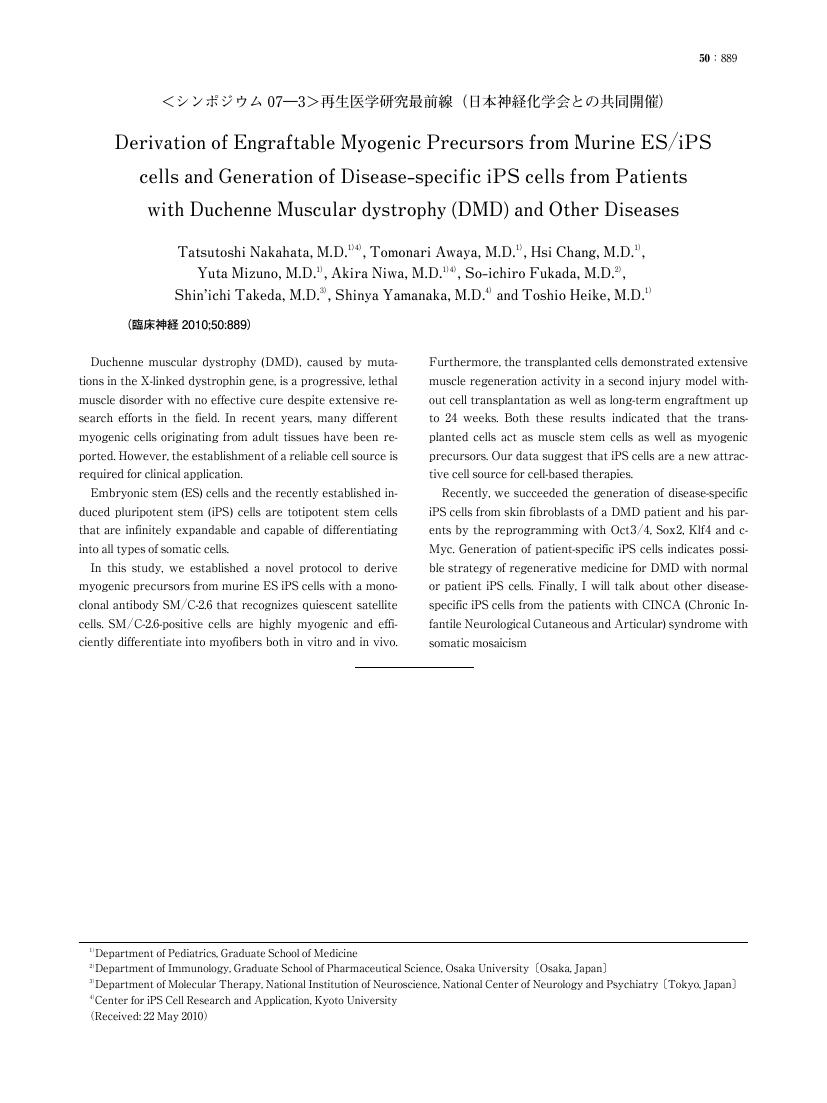- 著者
- Shinya Yamanaka [著]
- 出版者
- [Shinya Yamanaka]
- 巻号頁・発行日
- 1993
- 著者
- Tatsutoshi Nakahata Tomonari Awaya Hsi Chang Yuta Mizuno Akira Niwa So-ichiro Fukada Shin'ichi Takeda Shinya Yamanaka Toshio Heike
- 出版者
- 日本神経学会
- 雑誌
- 臨床神経学 (ISSN:0009918X)
- 巻号頁・発行日
- vol.50, no.11, pp.889-889, 2010 (Released:2011-03-28)
- 被引用文献数
- 2 2
- 著者
- Tsukasa Kamakura Takeru Makiyama Kenichi Sasaki Yoshinori Yoshida Yimin Wuriyanghai Jiarong Chen Tetsuhisa Hattori Seiko Ohno Toru Kita Minoru Horie Shinya Yamanaka Takeshi Kimura
- 出版者
- 日本循環器学会
- 雑誌
- Circulation Journal (ISSN:13469843)
- 巻号頁・発行日
- pp.CJ-12-0987, (Released:2013-02-09)
- 参考文献数
- 34
- 被引用文献数
- 28 221
Background: In the short- to mid-term, cardiomyocytes generated from human-induced pluripotent stem cells (hiPSC-CMs) have been reported to be less mature than those of adult hearts. However, the maturation process in a long-term culture remains unknown. Methods and Results: A hiPSC clone generated from a healthy control was differentiated into CMs through embryoid body (EB) formation. The ultrastructural characteristics and gene expressions of spontaneously contracting EBs were analyzed through 1-year of culture after cardiac differentiation was initiated. The 14-day-old EBs contained a low number of myofibrils, which lacked alignment, and immature high-density Z-bands lacking A-, H-, I-, and M-bands. Through the long-term culture up to 180 days, the myofibrils became more tightly packed and formed parallel arrays accompanied by the appearance of mature Z-, A-, H-, and I-bands, but not M-bands. Notably, M-bands were finally detected in 360-day-old EBs. The expression levels of the M-band-specific genes in hiPSC-CMs remained lower in comparison with those in the adult heart. Immunocytochemistry indicated increasing number of MLC2v-positive/MLC2a-negative cells with decreasing number of MLC2v/MLC2a double-positive cells, indicating maturing of ventricular-type CMs. Conclusions: The structural maturation process of hiPSC-CMs through 1-year of culture revealed ultrastructural sarcomeric changes accompanied by delayed formation of M-bands. Our study provides new insight into the maturation process of hiPSC-CMs.
- 著者
- Keisuke Okita Shinya Yamanaka
- 出版者
- 日本炎症・再生医学会
- 雑誌
- Inflammation and Regeneration (ISSN:18809693)
- 巻号頁・発行日
- vol.28, no.6, pp.510-515, 2008 (Released:2009-12-28)
- 参考文献数
- 50
We have previously shown that embryonic stem (ES)-like cells can be induced from mouse fibroblasts, hepatocytes and stomach epithelial cells by introducing four factors (Oct3/4, Sox2, c-Myc, and Klf4). The cells are similar in morphology, proliferation and gene expression profile to those of ES cells, and are called induced pluripotent stem (iPS) cells. When the iPS cells are transferred into blastocyst, they can contribute to adult chimeric mice and transmit through germline to the next generation. Therefore iPS cells have almost same differentiation potential as ES cells. In 2007, we and others reported the establishment of iPS cells from human somatic cells and showed their pluripotency.These iPS cells would supply patient-specific pluripotent stem cells for cell transplantation therapies. However, iPS cells still have several problems to be overcome, especially tumorigenicity owing to the use of oncogenes and retrovirus. Recent studies revealed that c-Myc is not a crucial factor for iPS induction, albeit it greatly increases the efficiency. The improvement of reprogramming efficiency was reported with soluble factor, Wnt3a, and several small molecules that influence epigenetic modification, such as BIX-01294 and VPA. Induction of mouse iPS cells without virus vector has been reported. Through the basic researches on iPS and ES cells, molecular mechanisms underlying the reprogramming process were gradually being uncovered. Here we try to summarize current studies on iPS cells. The iPS cells will contribute to the fields ofelucidation of pathogenesis, drug discovery, toxicology study, and cell transplantation therapy in the future.
